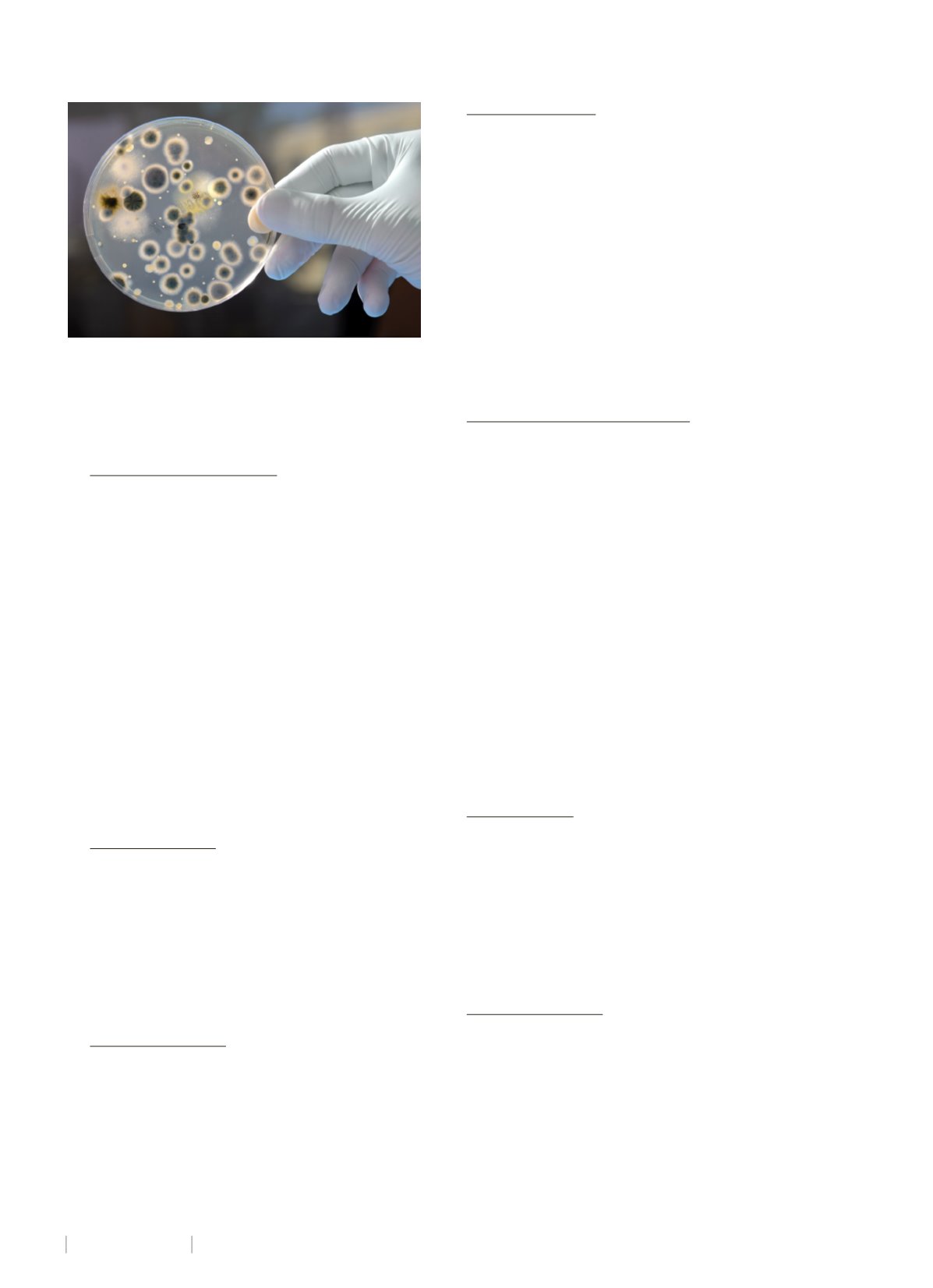
20
C
over Story
เชื้
อไม่
สามารถทำ
�ลายจุ
ลิ
นทรี
ย์
เหล่
านี้
ได้
สั
ตว์
จะเป็
นตั
วกลางของเชื้
อ
จุ
ลิ
นทรี
ย์
กลุ่
มนี้
สู่
กระบวนการเชื
อดและเดิ
นทางไปสู่
ผู้
บริ
โภคอาหารที่
ผลิ
ตจากสั
ตว์
เหล่
านี้
ในที่
สุ
ด
การพั
ฒนาเศรษฐกิ
จและการใช้
พื้
นที่
จำ
�นวนของฟาร์
มเลี้
ยงสั
ตว์
ลดลงโดยแต่
ละแห่
งมี
พื้
นที่
เพิ่
มมากขึ้
น
ทำ
�ให้
สั
ตว์
ถู
กเลี้
ยงแน่
นขึ้
น โอกาสในการปนเปื้
อนจุ
ลิ
นทรี
ย์
ข้
ามระหว่
าง
สั
ตว์
แต่
ละตั
วก็
จะมากขึ้
นตามไปด้
วย นอกจากนั้
น การจั
ดการมู
ล
สั
ตว์
นั้
นเป็
นเรื่
องยุ่
งยากมากขึ้
น มู
ลสั
ตว์
จะถู
กนำ
�ไปทำ
�ฝั
งหรื
อกองทิ้
ง
ไว้
บนพื้
นดิ
น แต่
ด้
วยปริ
มาณที่
มากในพื้
นที่
แคบๆ ทำ
�ให้
น้ำ
�ผิ
วดิ
นและ
ใต้
ดิ
นมี
โอกาสปนเปื้
อนมากขึ้
น ส่
วนพื้
นที่
สำ
�หรั
บเพาะปลู
กพื
ชอาหาร
ไม่
สามารถสร้
างผลผลิ
ตให้
เพี
ยงพอกั
บความต้
องการ ทำ
�ให้
พื้
นที่
ผลิ
ต
และเก็
บเกี่
ยวอาจเปลี่
ยนแปลงไป
มาตรการควบคุ
ม
เป้
าหมายอั
นดั
บแรกของการตรวจสอบการระบาดของโรคคื
อการควบคุ
ม
ผลกระทบต่
อระบบสาธารณสุ
ข และการยั
บยั
้
งการแพร่
ระบาดในอนาคต
ในขณะเดี
ยวกั
น การแทรกแซง เช่
น การเรี
ยกคื
นผลิ
ตภั
ณฑ์
อาจส่
ง
ผลกระทบต่
อเศรษฐกิ
จและส่
งผลทางกฎหมายได้
อย่
างรุ
นแรง จึ
งต้
อง
ใช้
การตั
ดสิ
นใจจากข้
อมู
ลที่
ถู
กต้
อง
การควบคุ
มแหล่
งอาหาร
การตรวจสอบจะจำ
�แนกความสั
มพั
นธ์
ระหว่
างอาหารแต่
ละชนิ
ด
หรื
อหลั
กฐานที่
เกี
่
ยวกั
บอาหารนั้
น และการเคลื่
อนย้
ายของจุ
ลิ
นทรี
ย์
ต้
องสงสั
ย การใช้
มาตรการเพื่
อควบคุ
มแหล่
งอาหารมี
ขั้
นตอนดั
งนี้
- เก็
บอาหารที่
มี
ปั
ญหาออกจากตลาด (การเรี
ยกคื
นอาหาร การเก็
บ
อาหารจากจุ
ดจำ
�หน่
าย)
- ปรั
บปรุ
งกระบวนการผลิ
ตหรื
อการเตรี
ยมอาหาร
- ปิ
ดสถานที่
ผลิ
ตอาหารหรื
อยั
บยั้
งการขายหรื
อใช้
อาหาร
การปิ
ดสถานที่
ผลิ
ตอาหาร
พื้
นที่
ที่
พบการปนเปื้
อนจะถู
กปิ
ดจนกระทั
่
งปั
ญหาได้
รั
บการแก้
ไข
อาจมาจากการทำ
�ข้
อตกลงของหน่
วยธุ
รกิ
จหรื
อบั
งคั
บโดยกฎหมาย
เมื่
อมี
การปิ
ดพื้
นที่
ที่
เกิ
ดปั
ญหา จะต้
องทำ
�การตรวจติ
ดตามโดยหน่
วย
งานรั
บผิ
ดชอบจนกระทั่
งหน่
วยงานนั
้
นจะรั
บรองว่
าสามารถเปิ
ดทำ
�การ
ต่
อได้
เกณฑ์
สำ
�หรั
บการเปิ
ดทำ
�การใหม่
ควรจะเป็
นไปตามอำ
�นาจตาม
กฎหมายและต้
องมาจากหน่
วยงานต่
างๆ ที่
มี
บทบาทในการตรวจสอบ
และควบคุ
มการแพร่
ระบาด
Microbial adaptation
Just as complex organisms have adapted to changing environments,
microbes likewise have adapted. Foods are often preserved by the use of
drying, salts, chemicals, acids and bases. Some pathogens have adapted to
living indry environments andothers can survive in acidic environments.
Products that are preserved utilizing these processes now need to be
more closely monitored for the presence of these adapted organisms.
Some organisms have become resistant to antibiotics. A strain of
salmonella
,
Salmonella
Typhimurium DT 104 is resistant to a series
of antimicrobials. Antibiotics no longer eliminate these infections
in animals and as a result, these animals may harbor these resistant
organisms at the time of slaughter and pass these organisms on to
consumers of food animal products.
Economic development and land use
The number of farms is decreasing but the size of the farms is
increasing. As a result animals are housedmore denselywhich increase
the spread of microorganisms between animals. Likewise manure
management becomesmore of a concern. Manure is reapplied to fields
but because of the amount that is generated in a small area, the potential
for runoff and groundwater contamination is increased. Areas inwhich
foods were originally harvested may no longer support a large enough
biomass to support economic harvesting. As a result production and
harvesting areas may change.
Control Measures
The primary goal of outbreak investigations is to control ongoing
public health threats and to prevent future outbreaks. At the same
time, specific interventions – such as recalling a food product – can
have serious economic and legal consequences and must be based on
accurate information.
Control of source
Once investigations have identified an associationbetween a particular
food or food premises and transmission of the suspected pathogen,
measures should be taken to control the source. Steps may include:
- Removing implicated foods from the market (food recall,
food seizure).
- Modifying a food production or preparation processes.
- Closing food premises or prohibiting the sale or use of foods.
Closing food premises
A contamination area is to be close the premises until the problem
has been solved. The agreement of the business or be enforced by law.
Once premises have been closed they should be monitored by the
responsible authorities and remain closed until appropriate authorities
approve their reopening. The criteria for reopening of establishments
may vary by jurisdiction and may involve input from various agencies
involved in the investigation and control of the outbreak.


